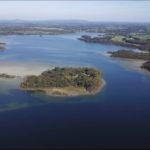The 4th November is the 52nd anniversary of the flooding…
The flood of Venice
Davide Gallazzi tells us about the flooding of Venice in November 2019. This flood was triggered by a combination of factors including rain, high tides and subsidence – all of which are predicted to be exacerbated in future by the impacts of climate change…
During November 2019, Venice was affected by a number of exceptionally high tides (“acqua alta”) which on the 12th reached a height of 187cm above sea level. This was the second highest tide on record, after the event of November 1966 (the same days as the Flood of Florence1) when the height recorded was of 196cm (Note: tide height measurements since 1872 are referred to the topographical landmark at Punta della Salute which was chosen due to its proximity to St. Mark’s Square. Due to the sea level rise and ground sinking, this landmark is nowadays ca. 36cm below sea level). An analysis of the historical data for tides at Venice allows to calculate a return period for the recent event of 160 years, while the 1966 event would have a return period of 1000 years.
Meteorological causes
Venice and in general all of the northern shores of the Adriatic Sea are prone to flooding due to high tides, and particularly so during the Autumn. This is in part due to meteorological and astronomical causes, like full moon, tidal cycle, atmospheric pressure and its local variations, which can trigger gradient currents capable of moving significant volumes of water, heavy rainfall and particularly the presence of a strong “Scirocco” (a wind blowing from SE) which on one hand obstructs the discharge of surface water into the sea, while on the other hand pushes sea water towards the northern shore.
All of these factors contributed to the event of the 12 November. In the specific, available data indicate that in the general area of Venice rainfall in the period 1-19 November 2019 was of 101mm (with particularly heavy rain on 3, 8-h, 12-13 November), 74% in excess of the average rainfall, atmospheric pressure on the 12 November was characterised by a low of 983mb centred in the area, with strong and persistent Scirocco with gusts of 90-120km/h.
Last but not least, the low-lying nature of the lagoon of Venice makes the city particularly sensible to global sea level rising. Comparison between data from Venice, Genoa and Trieste indicate a long-term trend of 1.4mm/year of sea level rise in the period 1890-2016, but with a rate of 3.68mm/year for the period 1994- 2016.

Geological causes
The lagoon of Venice formed around 7,000 years ago when ice-thawing after the last glaciation lead to sea inundation of the northern part of the Adriatic Sea. Consequently, the lagoon is underlain by approximately 1,000m of fluvio-glacial sediments, which are sinking due to compaction. It appears though that in historic centre of Venice this geological cause is less important than it was generally thought. Data collected since the beginning of satellite monitoring ca. 20 years ago indicate that this area is relatively stable if not even raising, possibly due to tectonic uplifting. Ground sinking rate has been measured reaching a maximum of 3-5mm/year near the Northern and Southern borders of the lagoon, and a rate of 1-3mm/year at the sand bars near the open sea.
Moreover, sea level rising in the lagoon of Venice is in part due to local human activities, and in particular the massive extraction of groundwater for industrial purposes, especially in the near-by refinery complex of Porto Marghera to the north west, which alone caused a sinking of ca. 12cm in the period 1930-1970. On this aspect, it is interesting to note that a positive consequence of the 1966 flood was a stronger attention to the dynamics of the lagoon which led to cessation of industrial groundwater extraction since 1970, at least in the area close to the actual historical settlement of the city. Groundwater extraction continues, even if at a lesser scale, in the northern part of the lagoon contributing to the general subsidence of the area.
Historical causes
It is curious to notice that Venice could be partially responsible for its own troubles. In fact, while in other parts of Italy (southern Tuscany and Latium regions) lagoons and coastal marsh areas were reclaimed through the centuries, the lagoon in Venice was preserved as such by a decision of the leaders of the Venice Republic (810-1797 CE) as it was considered to be an extremely valuable protection against the risk of an invasion via land, a factor so important as to over-weigh the associated malaria and lack of agricultural land near the city. To protect the lagoon, the course of all the local rivers was repeatedly modified to prevent infilling by sediments. The body overseeing such aspect, il “Magistrato delle Acque” (Water Commission) had a main role in the administrative machine of the Venice Republic, and as such its activities were completely independent and strongly protected from any political or administrative interference.

Future scenarios
A recent study of the area predicts that sea level rise (whatever the cause) even in the case of a moderate scenario (the so called: IPCC A1B), would bring the average sea-water level between 17cm and 53cm higher by 2100. This figure may sound small, but it should be noticed that when the tide reaches +80cm St. Mark’s Square (the lowest point in the city) starts to flood; when the tide reaches +110cm circa 12% of the city gets flooded, and with tides of +130cm flooding affects approximately 70% of the whole city. Therefore, tides higher than 110cm may repeat between 20 and 250 times per year. Another study examining a worst case scenario, forecasted a natural subsidence of 3.3mm/year, with a consequent average sea level rise between 60cm and 82cm by 2100. Hence, acqua alta could reach over 2.50m, turning the exceptional circumstances of these days into a day-to-day occurrence. These dramatic predictions are to an extent anticipated by the increasing yearly frequency of medium-high tides (i.e. 80-109cm a.s.l, Figure 1, top) and high tides (i.e. at least +110cm, Figure 1, bottom), as shown above.







